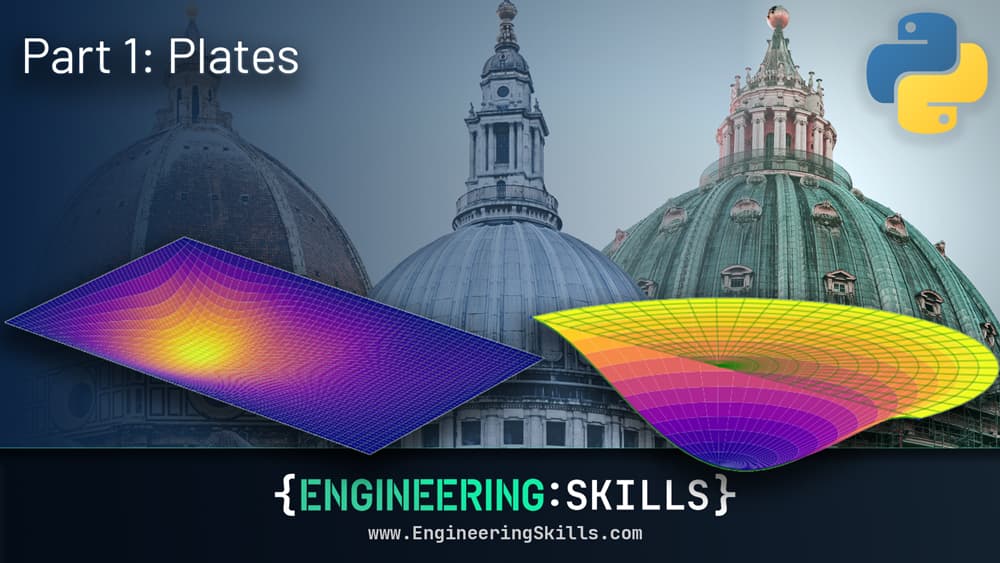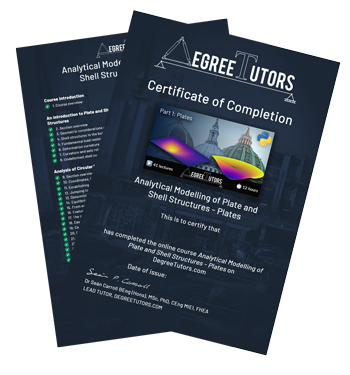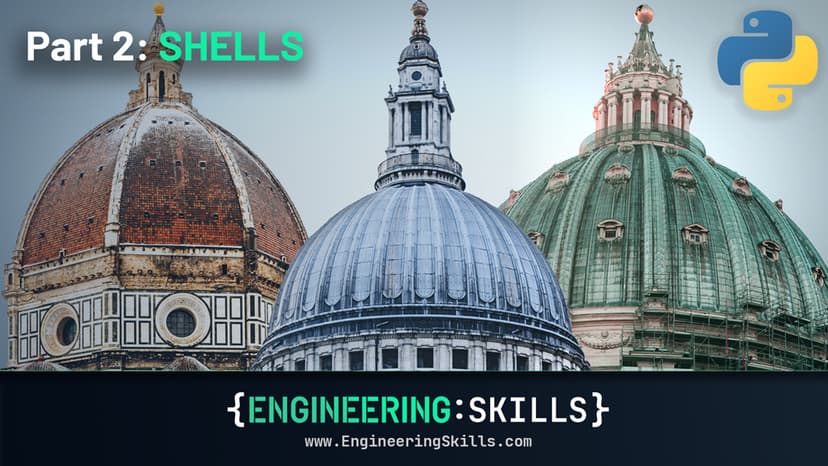
Analytical Modelling of Plate and Shell Structures: Part 1 - Plates
A practical guide to the analysis of circular and rectangular plates under load, from first principles.
- You will develop a deep ‘first principles’ understanding of plate-bending behaviour – critical for the safe application of finite element solutions.
- You will develop tools and techniques for solving the governing differential equations and unlocking the flexural behaviour of the rectangular and circular plates.
- You will be comfortable using Python’s SymPy library to work with symbolic math and turn symbolic expressions into graphical representations of plate deflection. (no prior Python knowledge assumed)
- You will understand how to apply Navier’s solution to approximate the solution to the governing differential equation for rectangular plate bending.
Plate structures are found all around the built environment. They are as fundamental to how we build modern structures as beams and columns. Yet, generally speaking, they are less well understood than linear elements.
In many cases, the need to analyse a 2D plate structure is met by finite element modelling. This gets us a quick solution but means we may never be forced to spend the time to understand the underlying mechanics – certainly not to the same degree that we understand beam bending or column buckling.
This course will help you rectify this! If you want to deploy FE with confidence, you should have a solid understanding of the fundamental behaviour first.
This course is part 1 in a two-part series exploring the analytical modelling of plate and shell structures. In this first part, we’ll be exploring 2D plates.
By the end of this course, you should have a good understanding of how to analyse both circular and rectangular plates using purely analytical means – so no finite elements or numerical methods – just fundamental closed-form solutions.

Although our analytical methods can only be practically deployed on idealised or simplified structures, they give us a foundation of knowledge that means we can use more sophisticated tools with greater confidence.
In addition to learning about the specifics of plate behaviour, you should also walk away with a better understanding of how to develop analytical models in the form of governing differential equations. You’ll also have a few new tools and techniques that you can use to unlock tricky math problems using Python.
Course Outline
The aim of this course is to:
- Help you develop a deep understanding of 2D plate behaviour and equip you with the tools and models to predict plate behaviour under load.
- Get you acquainted with using Python as a tool to work with symbolic mathematics. With this skillset, you need never shy away from a meaty mathematical derivation or differential equation again!
The course is divided into 4 sections.
Section 1: Course Introduction
As is now customary for an EngineeringSkills course, section 1 is really just aimed at covering some housekeeping issues. I’ll give you a quick video introduction to the course, so you know what to expect and flag up how to get additional support through the community forum. We won’t spend long here!
Section 2: An Introduction to Plate and Shell Structures
In the next section, we’ll start by clearly defining the types of structures we want to study and outline the assumptions and limitations that will apply to everything we discuss throughout the course. We’ll also briefly consider the historical context and see how important shell structures have been to the evolution of the built environment over the last 2000 years.
By the end of this section, you’ll have a conceptual understanding of how plates and shells resist transverse loading, you’ll be familiar with the relevant terminology used in their analysis, and you’ll be able to classify shell structures based on their principal curvatures.

Section 3: Analysis of Circular Plates
In section three, we move on to the analysis of circular plates. Circular plates are a great starting point because they provide us with a relatively straightforward structure from which we can develop our mechanical model.
This section can be divided into two halves; in the first, we derive the governing differential equation for plate bending. In the second, we’ll focus on putting our model of plate behaviour to work by considering various analysis case studies.

In this section, we’ll use Python to help us with the heavy lifting of analytically solving the differential equation. Making use of Python in this way dramatically reduces the tedious work of manipulating and solving complex equations and is a skill you can easily deploy elsewhere.
Section 4: Analysis of Rectangular Plates
In the final section of the course, we’ll transition to rectangular plates. Just as in section 3, we’ll start with a description of the fundamental geometry of plate deformation and build, step-by-step, to a point where we can start to analyse plate behaviour.
We’ll spend quite a lot of time in this section on Navier’s solution for simply supported rectangular plates subject to various loading conditions. Our goal at the end of this section is to have a ‘Python Plate Calculator‘ that parameterises and automates our plate analysis.

The main aim of this section is to get you thinking about how you can use programming as a simple tool to speed up your engineering calculations and analysis workflows. You’ll find that with a little practice, scripting in Python (or any other language you like) is far superior to a spreadsheet when managing engineering calculations.
Once you’ve finished this section, you should be comfortable expanding your analysis scripts to cover other analyses from the course.
But the big win from this section will be the application of scripting to your other engineering analyses and workflows.
Who this course is for
- Students and practising civil and structural engineers who want to develop a first principles understanding of 2D plate behaviour.
- Engineers who use finite element methods to perform plate/floor slab analysis but want a deeper understanding of plate mechanics.
- Anyone who wants to explore how Python can be used to perform symbolic mathematical operations, eliminating the need to carry out complex procedural operations by hand using memory of ‘the rules’.
The codes developed in this course are for educational purposes only and are not tested or certified for use beyond the educational scope of this course. Always employ your own engineering judgement first and foremost, regardless of what the computer says!

Download your personalised Certificate of Completion once you’ve finished all course lectures.
Applying for jobs? Use your Certificate of Completion to show prospective employers what you’ve been doing to improve your capabilities.
Independently completing an online course is an achievement. Let people know about it by posting your Certificate of Completion on your Linkedin profile or workplace CPD portfolio.
The Analytical Modelling of Plates and Shells Course Bundle
Unlock the behaviour of plates and shells and build strategies for tackling math-heavy analyses.
- Analytical Modelling of Plate and Shell Structures: Part 1 - Plates
- Analytical Modelling of Plate and Shell Structures: Part 2 - Shells

